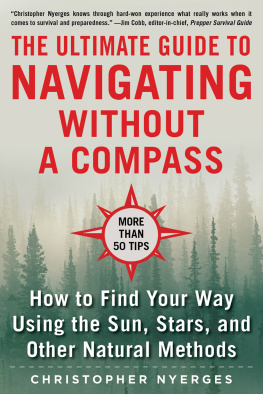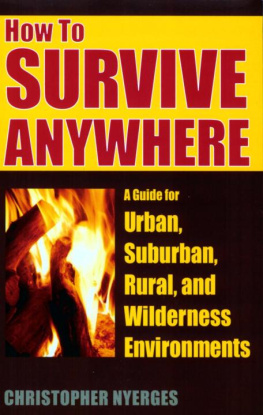Christopher Nyerges - The Ultimate Guide to Navigating without a Compass
Here you can read online Christopher Nyerges - The Ultimate Guide to Navigating without a Compass full text of the book (entire story) in english for free. Download pdf and epub, get meaning, cover and reviews about this ebook. year: 2019, publisher: Skyhorse, genre: Science fiction. Description of the work, (preface) as well as reviews are available. Best literature library LitArk.com created for fans of good reading and offers a wide selection of genres:
Romance novel
Science fiction
Adventure
Detective
Science
History
Home and family
Prose
Art
Politics
Computer
Non-fiction
Religion
Business
Children
Humor
Choose a favorite category and find really read worthwhile books. Enjoy immersion in the world of imagination, feel the emotions of the characters or learn something new for yourself, make an fascinating discovery.
- Book:The Ultimate Guide to Navigating without a Compass
- Author:
- Publisher:Skyhorse
- Genre:
- Year:2019
- Rating:4 / 5
- Favourites:Add to favourites
- Your mark:
- 80
- 1
- 2
- 3
- 4
- 5
The Ultimate Guide to Navigating without a Compass: summary, description and annotation
We offer to read an annotation, description, summary or preface (depends on what the author of the book "The Ultimate Guide to Navigating without a Compass" wrote himself). If you haven't found the necessary information about the book — write in the comments, we will try to find it.
The Ultimate Guide to Navigating without a Compass — read online for free the complete book (whole text) full work
Below is the text of the book, divided by pages. System saving the place of the last page read, allows you to conveniently read the book "The Ultimate Guide to Navigating without a Compass" online for free, without having to search again every time where you left off. Put a bookmark, and you can go to the page where you finished reading at any time.
Font size:
Interval:
Bookmark:



Copyright 2020 by Christopher Nygeres
All rights reserved. No part of this book may be reproduced in any manner without the express written consent of the publisher, except in the case of brief excerpts in critical reviews or articles. All inquiries should be addressed to Skyhorse Publishing, 307 West 36th Street, 11th Floor, New York, NY 10018.
Skyhorse Publishing books may be purchased in bulk at special discounts for sales promotion, corporate gifts, fund-raising, or educational purposes. Special editions can also be created to specifications. For details, contact the Special Sales Department, Skyhorse Publishing, 307 West 36th Street, 11th Floor, New York, NY 10018 or .
Skyhorse and Skyhorse Publishing are registered trademarks of Skyhorse Publishing, Inc., a Delaware corporation.
Visit our website at www.skyhorsepublishing.com.
10 9 8 7 6 5 4 3 2 1
Library of Congress Cataloging-in-Publication Data is available on file.
Cover design by Tom Lau
All photos courtesy of the author, unless otherwise noted.
Print ISBN: 978-1-5107-4990-0
Ebook ISBN: 978-1-5107-4992-4
Printed in China.

TABLE OF CONTENTS
ACKNOWLEDGMENTS
Ive been trying to get somewhere all my life, and have always been interested in the concept of direction and how to accurately navigate from place to place. Its not as complicated as you might think, but it does take the constant paying of attention. I think Ive compiled just about every tidbit about orienteering and natural navigation Ive ever heard in this book, and it came from many sources.
In my early years, I loved the writings of Bradford Angier and Ellsworth Jaegar, as well as the more practical writings of Bjrn Kjellstrm. In the real world, Ive learned much from my companions and associates, such as Ron Hood (of Survival.com), Abbey Keith (of the Sierra Madre Search and Rescue team), and my fellow members of Dirttime: Dude McLean, Alan Halcon, and John McCann. Halcon spent a considerable amount of his time assisting me in making this book as good as possible, given our constraints of time and space.
In the early days, Richard E. White encouraged me to learn how sundials and sun compasses work, and how to make them. My astronomy teacher at Pasadena City College, Mr. Eaton, taught me that so much of this is pure mathYoull never get this if you dont grasp the math, he would tell us. I learned quickly when I was asked to teach how to use a map and compass through the WTI Survival Training School, and through Pasadena City College. Teaching demonstrates that you know, or you dont know, and I quickly learned what I did not know.
Even my father began my navigation training early, when he drilled into me how and where to walk home from kindergarten and grade school, with a specific pattern, and always observing the unexpected, so that the boogeyman doesnt get you. I extend my gratitude to each of you who assisted me on this path.
INTRODUCTION
TIME AND DIRECTION
Natural navigation, and the observation of the sun, moon, and stars, is a complex process that also necessarily involves the concepts of time and time-keeping. Sundials and compasses are intimately related, for example. But our focus here is navigation, with or without a compass, and so we will address the motions of the earth, sun, moon, and stars as they pertain to navigation primarily, and as they relate to time-keeping only when necessary.
Ancient people did not have any of our modern technology, and so they developed an acute awareness of their environments, including the movement of the sun, the moon, and the stars. They knew where they were in relation to other things, and they developed unique tools for maintaining this sense of awareness.
Modern people rarely think about north vs. south, the divisions of time, or how these things are figured, adjusted, or corrected. Why? Weve let our technological tools do this work for us, and as an unintended consequence, weve grown increasingly unaware and ignorant of our surroundings.
In this book, we hope to awaken in you that excitement that comes with learning how to determine north from the stars, how to determine east from the sun, and how to use your natural sense of awareness to guide you.
This book is an excellent first step towards developing those skills which will lead to a greater sense of directionin the city, or in the woods.
Q: Is it true that you were once hopelessly lost in the woods?
A: No, but I was very confused for a few days.
Remember, youre not lost. Its your camp that is lost.
Ellsworth Jaeger

CHAPTER 1
NATURAL OBSERVATIONS
You want to go natural. You want to shed all vestiges of civilization and throw away your maps and compasses, and learn to live off the land and read the landscape like a native. Right?
How do you do so?
In fact, there is no single natural observation that will tell you directions. You need to be observant of many features and understand what they mean. You need to use your common sense and you need to be able to think on your feet. Then, with practice, you stand a good chance of determining compass points and knowing how to get around without modern devices.
Here are a few of those general guidelines. Keep in mind that some would put these observations into the category of folklore. This is because they are general guidelines. Rely on these alone and you may still remain hopelessly lost. In fact, I was once pompously informed that I should not teach any such navigation techniques if they are not foolproof and 100 percent accurate all the time. Really? Though the person who told me that probably had the best of intentions, I merely responded, Welcome to the real world. In the real world that I have come to know, this world that we are going to learn to navigate, we need to blend subjectivity with objectivity, hard facts with intuition, pragmatism with pleasure, as well as the hard fact versus harsh realities.
Getting Yourself Oriented
Studying the Lay of the Land
The best way to understand the landscape youre in is to get to a high spot where you can observe as much of the local terrain as possible. Get up to a rocky peak, or some high area with an unimpeded view of the terrain. Once, when there was no such high spot, I actually climbed a tree in order to get a look at the lay of the land.
Look for the flat zoneswhere water flows, the high peaks, the undulating valleysanything that relates to your ability to travel and to obtain water. If you have the ability to jot down in a notebook some of your observations, you should do so, especially if its your first time in a new area.

Observe your landscape, ideally from a high elevation. Binoculars can help you spot details.
Observing where water flows is important from a navigational standpoint because you might have to cross a body of water. Youll need to go around, or cross it where the river is either narrowest (where it would be easy to have a makeshift bridge), or where the river is widest (where the water is the most shallow). Also, there are often trails along a river or stream because they are often easy to follow, and easy to get to the next town or village downstream. (Remember, often is not synonymous with always.)
Next pageFont size:
Interval:
Bookmark:
Similar books «The Ultimate Guide to Navigating without a Compass»
Look at similar books to The Ultimate Guide to Navigating without a Compass. We have selected literature similar in name and meaning in the hope of providing readers with more options to find new, interesting, not yet read works.
Discussion, reviews of the book The Ultimate Guide to Navigating without a Compass and just readers' own opinions. Leave your comments, write what you think about the work, its meaning or the main characters. Specify what exactly you liked and what you didn't like, and why you think so.










